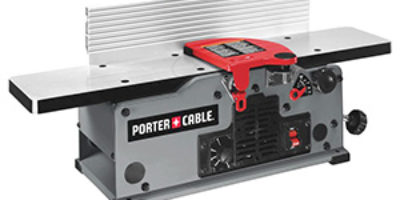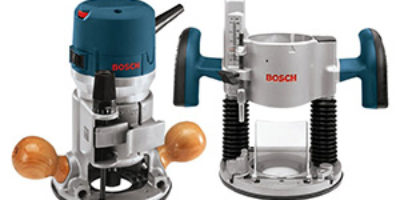We may receive a commission for products purchased through the links on our site at NO additional cost to you.
Did you know that the best electric hand planer for your job exists? That’s right. All it takes to discover the best hand planer is some research, a little time, and checking our electric hand planer reviews. We can provide help with that. Your choice in selecting the best electric planer will come once you know more about power planers and their features. We will look into five solid options before going into more detail on what makes an electric hand planer great. The greatest tool is the one that works with you – not against you. Keep reading to discover that tool with us.
Best Hand Planer Reviews – Top 5
[go_pricing id=”best_electric_hand_planers”]1. WEN 6534 Electric Hand Planer
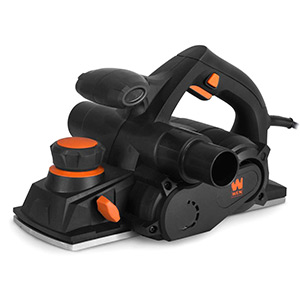
WEN is a name that should be familiar if you have ever browsed power tools. If you have not, don’t worry. All you need to know is that they have been around since 1951 and were pioneers in power tools. Their tools are often of high quality and great value. The 6534 electric hand planer is no exception in this manner.
The 6534 includes an 8-amp motor. This is more than the standard in the world of electric handheld planers. You can expect 32,000 (CPM) cuts per minute at that amperage. The cutting width is 4-3/8 inches with a maximum depth of 1/8 inch. This is ideal for adapting to many cutting situations.
There are 16 positive stops. The stops are in increments of 1/128 inches from 0 inches to 1/8 inches. This gives you lots of room for adjustments and versatility in the projects you will be working on.
Pros:
- Has a powerful motor. This makes it suitable for a wide variety of tasks.
- Has a reversible dust chute. That is awesome for being in control of where the dust is ejected.
- Comes with a solid kickstand. It is solid, and keeps the planer off of the surface when you don’t want it to be.
- Includes a mountable dust bag. The dust bag is small, but it does a fine job of collecting the inevitable dust from cutting.
- Provides a built-in parallel fence bracket.
Cons:
- The blades gets worn out quickly from prolonged use.
- Possible overheating problems.
2. Porter Cable PC60THP Power Planer
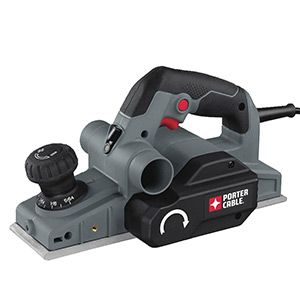
Porter Cable is another common name in the power tool world. Thus it is no surprise that they have a dedicated line of reliable electric hand planers. In particular, we have our eyes on the PC60THP. It has a powerful 6-amp motor, 3 chamfering grooves, and dual dust extraction. The motor runs at 16,500 RPM which is more than enough for smoothing wood.
The PC60THP has a depth knob for choosing the right increments for the cut. There are 10 in total, giving you a decent selection of positive stops. While other planers have more positive stops, this is not a huge deal breaker. 10 is usually plenty.
Also to note is that the PC60THP provides a cutting depth of 5/64 inches. It also has a max rabbit depth of .47 inches. This planer comes with a nice set of accessories, including two carbide blades, a wrench, a dust bag, an edge guide, and a carrying bag.
Pros:
- The aluminum shoe is a feature we wish we saw more often. It offers extra control and leads to better cuts. This means a smoother finish.
- Depth knob is good for control. With it, you can easily set the depth of each cut.
- At just above 7 pounds, the PC60THP is lightweight enough for everyday use.
- 3-1/4 heavy duty electric planer with solid build. The tool is solid and feels heavy-duty in our hands. Expect quality here.
- Great accessories included. It is refreshing to see a company put in extra thought in it’s product offerings.
Cons:
- Blade change and blade adjustment is not easy.
- Pop-out safety can be cumbersome.
3. Bosch PL2632K Handheld Planer
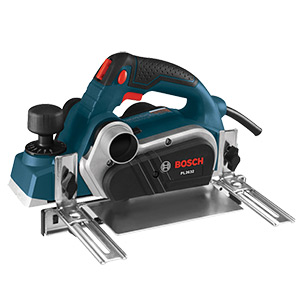
Bosch PL2632K is a fantastic tool. That is to be expected. Bosch is old. We mean, really old. They were founded in 1886 and have provided quality tools since. Their power tool line is testament to their quality.
Bosch’s 3-1/4 planer has a 6.5 amp motor that runs at 16,500 RPM. This is the standard for small electric planers. At that RPM you can expect fast cuts, quick stain removal, and control over all woods. Hardwoods or softwoods, the PL2632K is excellent at doing its job.
The planing width is 0 inches to 3-1/4 inches. The depth is adjustable from 0 to 3/32 inches. With a rabetting depth of 11/32 inches. You’ll have good options if you need them (and most of us do).
The cord is also worth mentioning. It has a ball-joint swivel. This keeps the cable from getting caught in one position and limiting your movement.
Pros:
- Very light, only 6.3 pounds, lighter than many electric hand planers on the market.
- Great amperage, 6.5 amps of pure power.
- The two-blade system is good if you need to cut more. This planer also handles larger, high-speed steel blades with no issue.
- Dual-mount guide fence. You can mount the fence on either side of the machine. This keeps the planing uniform from start to finish.
- Ambidextrous lock-off button. That keeps safety in mind by making unwanted starts less likely.
Cons:
- Dust bag doesn’t fit perfectly.
- The aluminum base scratches too easily.
4. Makita XPK01Z Electric Planer
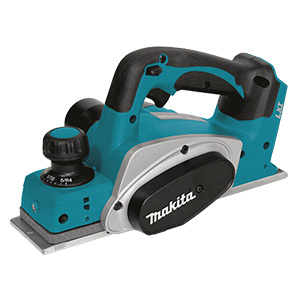
The Makita XPK01Z is an 18-volt cordless planer powered by lithium-ion batteries for surefire performance. It boasts cordless design, ease-of-use, fast blade swapping, and comfortable handling.
The XPK01Z has a 3-1/4 inch width and 5/64 inches of depth. The two-blade cutter comes with carbide blades. This makes those cuts smooth. The weight of this one is 7.4 pounds with the battery. That is more than others reviewed here, but we did not find it to be tiresome in the least.
The 18-volt motor only allows for 14,000 RPM, but we believe that it is plenty of powerful for quick stock removal. The XPK01Z has no problems shaving down most types of wood.
Finally, it’s designed to be used by a plethora of professionals and hobbyists alike. That includes carpenters, contractors, door and window installers.
Pros:
- The click knob adjusts the depth almost immediately. This is great for quick adjustments.
- The aluminum base allows for accuracy while planing. It has a durable and smooth finish to it.
- We liked the XPK01Z because of how comfortable it is to work with. The grip is easy on the hands. It is easy to grip and offers plenty of support.
- Fast and easy blade removal.
Cons:
- Lowest RPM on this list.
- Somehow short battery life.
5. DeWalt DCP580B Cordless Hand Planer
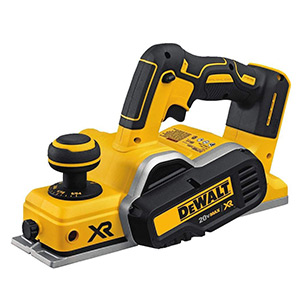
DeWalt tools are a power tool standard. If you have ever browsed power tools at your local hardware store, chances are you have seen their name and signature yellow designs. The DCP580B 20V MAX brushless planer is a superb contender for the best electric hand planers.
At just 5.5 pounds, the cordless DCP580B has a brushless motor and a 20-volt battery. The maximum depth is 5/64 inches. The planing width is the typical 3-1/4 inches, as is expected.
Aluminum shoes sit at the front and back of the tool and allow for straight, parallel cuts. The front shoe is grooved for chamfering. We liked the overall ergonomic design of this particular planer and it is comfortable to operate.
30,000 cuts per minute (CPM) are averaged from the 15,000 RPM motor. While lower than others, that is more than likely enough for most jobs.
Pros:
- Cordless for less movement restrictions. This is a huge pro – especially if you are working at a job site that requires lots of movement.
- The planing with this tool is accurate. The motor is powerful enough to give strong cuts. It also allows for the removal of most finishes from the wood surface.
- Easily adjustable guide, very easy to setup and use.
- The motor is quiet, too. That is a plus if working indoors.
Cons:
- Mildly slower RPM than others and have slightly fewer cuts per minute.
- Dust bag, battery, and charger are sold separately.
Best Electric Hand Planer Comparison Table
| Product/Feature | Blades | Cutting Width | Cutting Depth | Rabbeting Depth | Depth Intervals |
|---|---|---|---|---|---|
| WEN 6534 | 2 HSS | 0 - 4⅜" | 0 - 1/8" | 0 - 1/3" | 1/128" |
| Porter Cable PC60THP | 2 Carbide | 0 - 3¼" | 0 - 5/64" | 0 - 3/64" | 1/64" |
| Bosch PL2632K | 2 Carbide | 0 - 3¼" | 0 - 3/32" | 0 - 5/16" | 1/256" |
| Makita XPK01Z | 2 Carbide | 0 - 3¼" | 0 - 5/64" | 0 - 11/32" | 1/256" |
| DeWalt DCP580B | 2 Carbide | 0 - 3¼" | 0 - 5/64" | 0 - 23/64" | 1/256" |
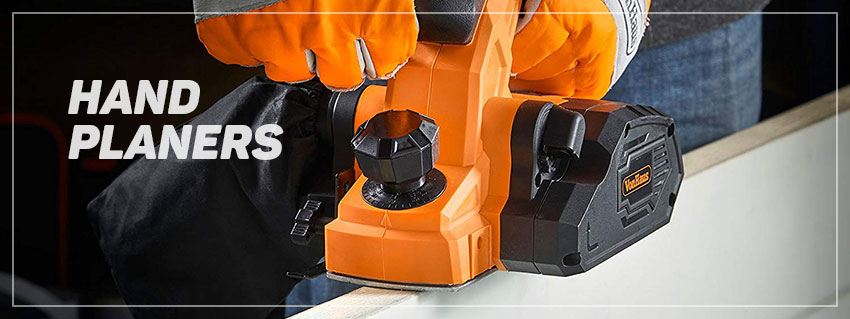
8 Steps Guide to Find the Best Electric Hand Planer
Purchasing the best electric wood planer can be intimidating – especially with so many options out there. We understand that, and that is why we have put together this guide. Forget about getting buried under piles of information. There are many routes to choose from when deciding on the best portable hand planer most suitable for your job site. Let’s get you to that decision to find the most suitable tool for your woodworking project.
-
Power Options Abound
An electric hand planer has a massive advantage over a manual one. Simply put, electric hand planers are more powerful. But not all hand planers are created equal. A corded planer will be able to squeeze a little extra juice out of the walls than a cordless, battery operated one. Both have their use cases, however, for the more mobile work, cordless wins hands down. If you are working in a workshop or consistent space, corded will do. Let’s look at the differences in power.
-
Corded
Most hand planers will have an amperage of 3.5 to 6 amps. The more powerful ones have an amperage of 7.5 to 8+ amps. An amp is just the basic unit of measuring electric current. The more amps, the more power the tool can use.
Corded planers have the benefit of never running out of electricity. Unless there is a power outage, you can work with your planer for much longer than a cordless one. You should keep an eye on how hot the tool is running. Blade life is another issue, but we will discuss that later in this guide.
-
Cordless
We know that it can be cumbersome having cables in your way. Cords can also become a safety hazard. The best cordless planers exist for that reason. Going cordless is sometimes more practical.
A typical voltage for a cordless planer is about 15 to 20 volts. Batteries tend to last for around fifteen minutes to half an hour of continuous use. You will hear the RPM declining as the battery power wanes. Purchasing a charger and extra batteries helps. However, if you opt out of buying extra batteries, you will need to be patient while waiting for your planer to charge.
-
Consider Your Speed Needs
It goes without saying that speed is a top priority. That’s why you chose an electric planer over a manual one. When looking at what is best you have to ask yourself: what am I going to use this for? If you are working with softwoods, a planer with around 15,000-16,000 RPM will suffice. Softwoods include: yew, pine, cedar, juniper, spruce, redwood
For the hardwoods with extra thickness – oak, mahogany, walnut, alder, and such – you need a planer that hits upwards of 15,000+ RPM. If you typically work with those tougher woods, do not be afraid to get the more powerful hand planer.
In our experience, if you work with a wide range of hardwoods and softwoods, go with a powerful planer. Cuts per minute, or CPM, is also vital. Aim for a tool that cuts at least 30,000-34,000 CPM.
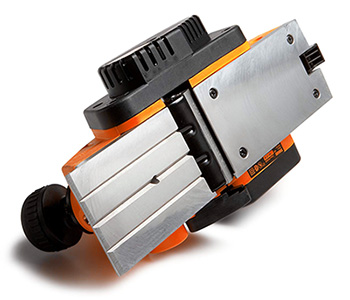
-
Battle of the Blades
Power may be important, but a planer is useless without its blades. That is why you are using it: to cut wood. A good electric planer will have durable, reversible blades. Carbide blades are common. Carbide is a compound of carbon and an electronegative element such as boron, tungsten, or iron. Tungsten carbide is often used for planer blades. High-speed steel (HSS) is also popular.
It is generally agreed upon that carbide blades trump high-speed steel in almost all use cases. You can expect to pay a little bit more for carbide, but the benefits are worth it. You will:
- Have more accurate cuts.
- Less resistance.
- Less heat buildup.
- A longer blade life.
-
Different Widths & Depths
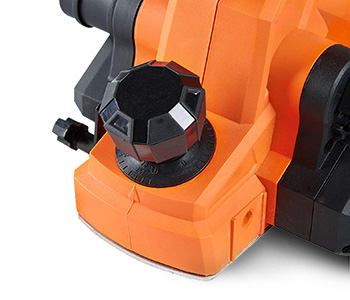
Rest assured that most – if not all – electric hand planers are adjustable. This means that you have options for fine tuning your cuts. Frequent cutting widths sit at 3-1/14 inches with a cutting depth of 1/8 inch. Usual increments of depth adjustment are 1/128 inch, from 0 to 1/8 inches. Great planers have more than a few positive stops. Common positive stop increments we found are 6, 10, and 16. One with 16 stops will give you the most control over your cuts.
-
Capacity
It is important for us to note that capacity varies between planers. The standard is around 3-1/4 inches, but that varies depending on the size of the planer. For most planing done by hand, 3-1/4 inches is sufficient. However, a great planer will be adjustable and allow more capacity.
-
Fence
A fence on a planer will decide how much accuracy and control you retain with each cut. The fence acts as a guide. We know all too well that making a cut by hand is really, really hard. Most quality electric planers have built-in fences. Less expensive ones might not. Keep that in mind before making a purchase.
-
Chips Ejection
As you cut, wood chips will be flying everywhere. It is important to pick out a planer that sends the chips in a direction that suits your working environment. Working out of a workshop, you will know where the chips should be going. You probably have a designated system for their disposal. However, if you work in varying locations, chip direction might not be as important. Regardless, we recommend that you look into the chip direction when you are buying your new hand planer.
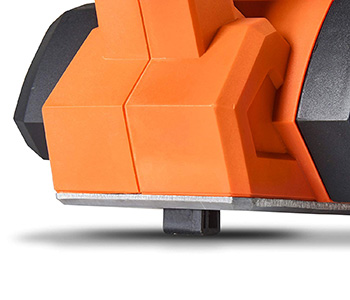
-
Useful Accessories
We love accessories. Many planers come useful accessories. Some of these can make your job easier. To get the most bang for your buck, look for deals that include:
- A rabbet guide.
- Extra blades.
- Batteries (if cordless).
- A fence bracket.
- Chamfer grooves.
This is especially key if you are just starting out with your first electric hand planer.
By now you have an idea of what to seek out when shopping around for the best power planer. We have been there, and we know how it is. Take this guide as a stepping stone. Consider what’s important to you, weigh your options, and get the best handheld planer that fits into your lifestyle, budget, and needs.
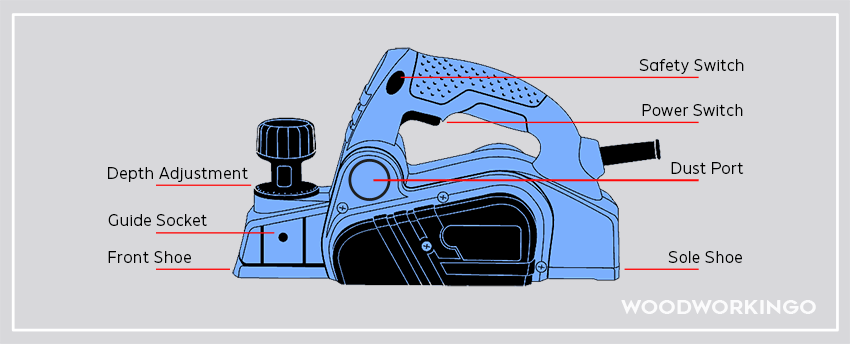
What is an Electric Hand Planer?
You have learned about a few great hand planers, but what exactly do hand planers do? What are they? Let’s find out together.
What Does an Electric Planer Do?
Like its traditional manual counterpart, an electric hand planer is a simple tool with many applications. It shaves wood down incrementally in order to shape it to the desired size or fit. This is done by pushing the planer along the wood. The result is a different size, a smooth surface, and a level plane.
Utilizing this tool is useful whether you are a passionate hobbyist or a working professional. Planers give you more control over the wood in ways that would be near-impossible by hand sanding or other applications. That is only the tip of the benefits iceberg.
What are the Benefits of a Hand Planer?
Oftentimes we find ourselves needing to smooth out a surface, filing it down, or shaping it for further work. Perhaps it is a door, a joist, or something larger. Sandpaper comes to mind as an obvious solution. Fire up the sander (or use your hands) and start smoothing. Easy, right?
An electric planer does that but with much more ease, comfort, and reliability. As we learned, a good hand planer is easy to control, durable, and efficient. Time will be saved in the long run. The whole project will benefit because you will have more energy to focus on other matters. Forget about being bogged down with the small things.
Another benefit is adaptability. An electric hand planer can adapt to many situations. But what exactly are electric hand planers used for?
What is a Handheld Electric Planer Used For?
Electric hand planers have a few uses. First and foremost, they are used to shave down wood. For the carpenter, a good electric planer will help in shaving doors, narrowing joists, and take care of most things that a sander cannot do. Sanders have limitations that planers do not. Other common uses for an electric hand planer include:
- Moulding
- Grooving
- Chamfering
- Leveling
- Size reduction
Even for the hobbyist home improvement lover, a great power planer will work wonders. We do not always have tons of time to invest in our projects. Trying to squeeze in an hour here or half an hour there limits what we can accomplish. However, with an electric hand planer, you can take full advantage of those tight efforts. But why choose an electric wood planer over a traditional manual one?
You may also find it useful to check our post of the best wood planers.
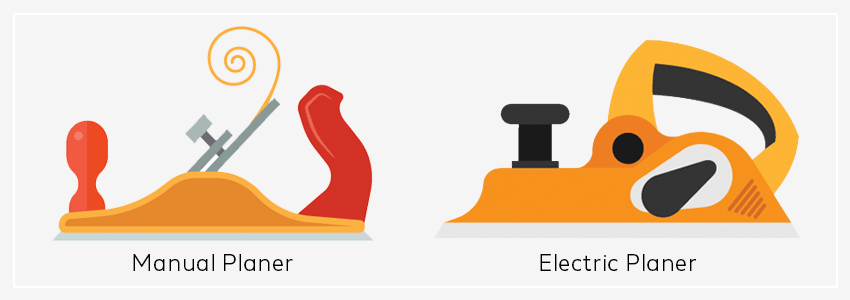
Electric Planers vs. Manual Planers
The most obvious benefit to using an electric planer is that it does not require much physical effort to operate. An electric planer has more cutting power. You are never limited by how hard you can push. The electric planer takes over in that respect.
This can save time, energy, and money in the long run. If you have ever used a manual hand planer you know that it can be grueling work. An electric planer eliminates this extra effort. We know from experience that this allows you to save energy for continuing your project. It is the sum of these little differences that give the electric tool the edge over the manual tool.
Keep in mind that we feel that electric planers are more suited for smaller surfaces. The cut is usually not as smooth or flat as a manual planer. However, the minor loss in surface quality is made up for with time. You can always come back afterwards and smooth by hand. Let the electric planer offset the heavy work.
Bottom Line
To wrap things up, we will say once more that the benefits to finding the best hand planer outweighs any difficulties in doing so. We know that by using our guide you will come across a tool that will suit your particular needs. Remember that there is no perfect tool for every job. The top rated electric hand planer is often what is available. Grabbing the best electric planer means that it will always be available when you need it. A great handheld planer is reliable, powerful, compact, and capable. We hope that you take this guide as a jumping off point. With the right amount of reading, digesting, and browsing you will find the best electric hand planer in no time through our power planer reviews.

